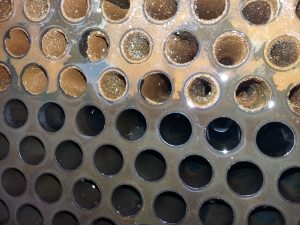During regular operation, condenser and heat exchanger tubes become fouled with various types of deposit that restrict flow, inhibit heat transfer, and ultimately degrade performance and lifespan of the unit. Various methods have been developed to remove these deposits, including: Water blasting with high pressure, Chemical cleaning, and Mechanical cleaning with water propulsion and metal tube cleaners.
Of these methods, mechanical cleaning with metal tube cleaners offers the best combination of speed (lower costs), safety, and cleaning quality. Because of the stark benefits of mechanical tube cleaning, this method has grown in popularity since its inception in the early 20th century to becoming the leading process used in the power generation industry in the United States. It is also quickly gaining in popularity in other industries and countries outside the U.S.
Benefits of Cleaning with Metal Tube Cleaners
Speed (Cost Savings)
The main benefit of the Projectile Tube Cleaning System is speed. Competing methods such as high-pressure blasting involve feeding a lance down the length of each tube to clean it. Pushing and pulling with the lance method is much more time consuming than shooting metal tube cleaners with a pumping system.
On an average mechanical tube cleaning job, a crew can clean approximately 500 tubes per hour. High-pressure blasting based methods can typically only achieve half this production rate. Since production rates are higher when cleaning condensers and heat exchanger with the projectile method, the job gets done faster and the price to clean this equipment is lower while providing the same end result of clean tubes.
Chemical cleaning of heat exchangers is also generally more expensive than mechanical cleaning. The chemical and disposal of the end solution increase the overall cost of the cleaning and ultimately makes mechanical cleaning more attractive.
Safety
Mechanical tube cleaning uses low pressure water (approximately 350 PSI) to propel metal tube cleaners down the tubes. The system has no inherent safety hazards. The use of low pressure water makes the system much safer than high-pressure water blasting, which typically utilizes water pressure of 10,000 PSI or higher.
Quality of Cleaning
Metal tube cleaners are specifically designed to remove deposition from tubes and return them back to base metal. These tube cleaners are designed to remove all types of deposits, including:
- Soft films of mud and clay
- Hard mineral or chemical depositions
- Biological macro-fouling, such as zebra mussels
- Etc…
Metal tube cleaners are often used before Eddy Current Testing or IRIS Testing. Metal tube cleaners have been successful at cleaning the tubes effectively so that Eddy Current and IRIS Tests can be successfully completed.
Misconceptions About Metal Tube Cleaners
One of the biggest misconceptions about metal tube cleaners out there is that while in use, they somehow damage the tubes they clean. Forms of this misconception usually come in two varieties: “metal tube cleaners remove base metal from tubes” and “since metal tube cleaners are typically constructed of carbon steel they should not be used on dissimilar metals such as stainless steel.” Both of these assertions are false and it has been tested time and time again that metal tube cleaners have no negative impact on the tube material.
Projectile Tube Cleaning has worked with countless customers to test the theory that metal tube cleaners remove base metal from tubes they are cleaning, and all independent tests have shown no base metal removed. The document below shows one such test.
This test was conducted independently by a generation facility, and was completed by shooting metal tube cleaners through the tubes and collecting the sample of the deposit on the outlet end. The deposit was then dried and analyzed for its composition. The tubes in this case were stainless steel and the test specifically looked for this variety of stainless steel in the deposit. After chemically analyzing the deposit, no tube material was found. This can be seen in both the elemental analysis in the top right of the document and the description in the bottom left of the document.
Countless other independent deposit tests have been carried out just like this one and have yielded the same result. To read the document in full, click here to download it.
Aside from independent tests, the record of metal tube cleaners stands as a testament that the process is safe and does not damage tube material. Projectile Tube Cleaning alone cleans millions of tubes a year of all metal varieties including copper-nickel, brass, titanium, stainless steel, carbon steel, etc. In the history of our company, there has never been any incident of tube damage from our products. Furthermore, the metal tube cleaner industry beyond Projectile Tube Cleaning has never had an incident of tube damage in the nearly 100 years of utilization of this technique. This record speaks for itself and the claims of tube damage are completely baseless and not factual.
For more information on how Projectile Tube Cleaning can help you with your cleaning condenser and heat exchanger tubes with metal tube cleaners, please contact us:


